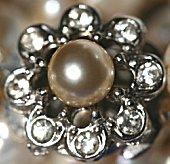
For many couples, traditional engagement ring designs are predictable and cliché, and they prefer more unique flower engagement rings. The variety of this figural design and its tremendous versatility make it perfect for many preferences, with the added benefit that it is often less expensive as well.
Designs for Flower Engagement Rings
When most people imagine a flower-shaped ring, they picture a cluster setting vaguely representative of a generic daisy. In truth, however, there are many ways to incorporate flowers into a range of ring designs, including:
- Filigree Engagement Rings: The delicate scrollwork of filigree rings can be fashioned as an intricate flowering vine highlighting one or more gemstone blooms.
- Art Deco Engagement Rings: The stylized nature of flower rings and the interconnected use of metal and colored gemstones is perfect for art deco styles.
- Celtic Engagement Rings: The symmetrical knot patterns of Celtic rings can be woven to mimic vines, leaves, and flowers.
- Engraved Engagement Rings: Small blooms can be engraved on the exterior of a wide band for a subtle floral accent.
Regardless of the design, the types of flowers, setting, metals, and gemstones can all be adjusted to create a distinctive personalized ring.
Types of Flowers

The easiest bloom to incorporate into flower engagement rings is the basic daisy: a central bud surrounded by evenly spaced, symmetrical petals. This simple design has many variations using different colors and size of semi-precious gemstones, but there are other flowers that can be used as well. A stylized poinsettia is easy to create with short, pointed petals, or a tulip can be fashioned into holding a single radiant gem. Antique engagement rings often feature stunning roses molded directly out of the ring's metal, with a small but beautiful gem nestled in the center.
Settings
Tiffany settings (prongs) are the most popular setting for floral rings, though they are not the only option. A bezel setting can highlight a gemstone and provide a smooth, uniform surface for "petals" to be attached, while a channel setting is suitable for any number of accent "leaves." Together, the daisy design of flower engagement rings is a cluster setting - the gems are clustered together to create the focal point.
Precious Metals
Couples who want a solitaire engagement ring often use different metals to accent the floral design rather than overload the ring with multiple petals and leaves. Rose gold is popular to add beauty and color to the ring, and its subtle pink hue is suitable for petals and other highlights. White gold is the most popular metal choice because it will not clash with colored gems, though yellow gold can add beauty and richness to many types of flowers.
Popular Gemstone Choices
There are hundreds of different gemstones in the world, any of which could make a gorgeous flower engagement ring. Before choosing a specific gem, however, couples should consider the overall appearance of the ring and its cost.
Shape
The most popular shape for floral rings is round: a round center stone surrounded by round petal stones. That is not the only option, however. Oval centers or petals add more uniqueness to the design, and some rings even feature trilliant shapes for leaves. Marquise shapes, with their extra length and pointed tips, are also popular choices.
Color
The color of the gemstones that make up the flower and leaves are widely varied. Popular options include:

- Pink: Pink diamonds, sapphires, rubies, topaz, and tourmaline offer various light and dark shades of pink for flowers.
- Red: Garnets, rubies, topaz, and coral all feature stunning shades of red.
- Yellow: Citrine, topaz, yellow diamonds, amber, and sapphires are popular options for yellow hues.
- White: A white flower center is popular if choosing colored petals; diamonds, pearls, and moonstone are all gorgeous options with a hint of traditionalism.
- Green: Peridot, jade, malachite, or emerald gems are perfect for rich green leaves.
Diamonds are the most expensive gemstone options, particularly fancy colored diamonds. Choosing synthetic diamonds or colored gems is a more affordable route, particularly since the ring will likely incorporate multiple gems.
Size
Gemstone carat size also plays a significant part in the ring's appearance and cost. Using a floral design maximizes the appearance of gemstones because the focus is on the entire ring rather than a single stone, allowing couples to opt for smaller, less expensive gems. The total carat weight of the ring may be greater than for a less elaborate design, however, which may increase the price substantially.Overall ring size is also important. Most floral designs are quite large once a center stone, petals, and a leaf or two is incorporated. This may not be the best choice for a bride-to-be with slender, small fingers - the ring will seem far too large for her and it will be more awkward to wear.
Benefits of Flower Engagement Rings
The beauty and uniqueness of floral rings attracts many couples to their unusual designs, and the versatility of the rings allows them to be easily adapted for different couples' preferences. Birthstones may be used to add layers of symbolism to the piece, while the exotic design is also suitable as a right hand ring after the wedding. The cost is generally lower than traditional diamond rings with larger, higher quality stones, and ultimately, the meaning of the ring may be far more substantial than a more predictable ring. Regardless of the design, size, or price, flower engagement rings are a fun, romantic symbol for couples about to embark on their happily ever after.







